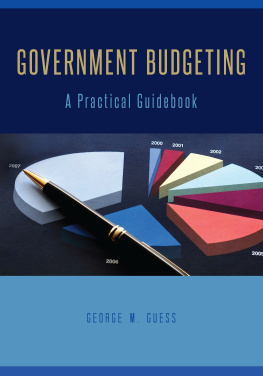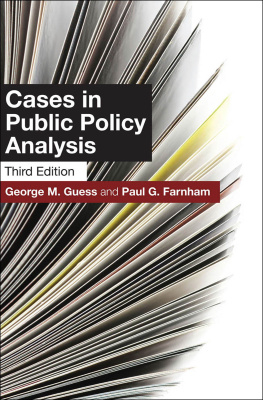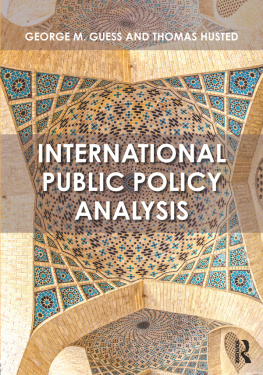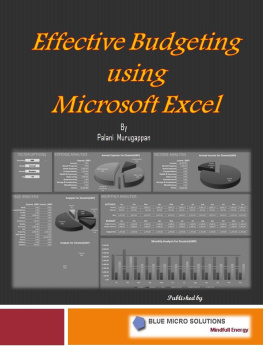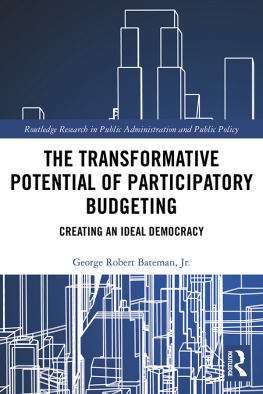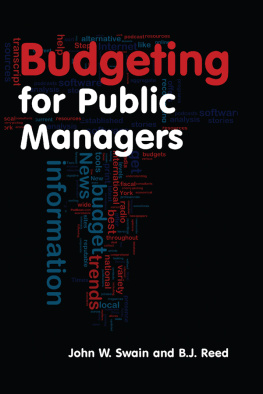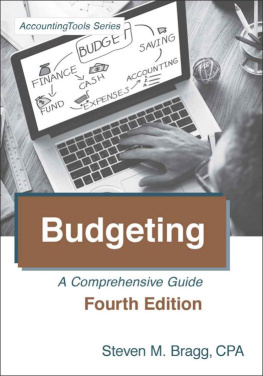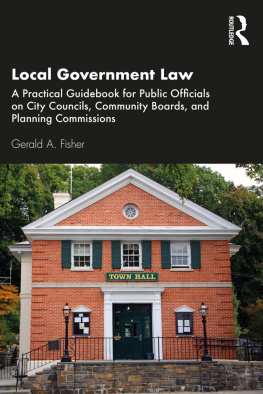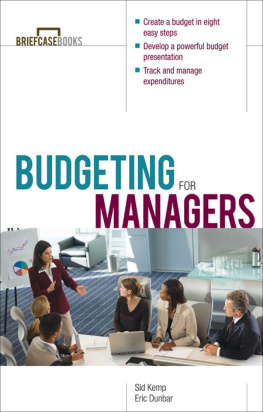Published by State University of New York Press, Albany
2015 State University of New York
All rights reserved
Printed in the United States of America
No part of this book may be used or reproduced in any manner whatsoever without written permission. No part of this book may be stored in a retrieval system or transmitted in any form or by any means including electronic, electrostatic, magnetic tape, mechanical, photocopying, recording, or otherwise without the prior permission in writing of the publisher.
For information, contact State University of New York Press, Albany, NY
www.sunypress.edu
Production, Ryan Morris
Marketing, Michael Campochiaro
Library of Congress Cataloging-in-Publication Data
Guess, George M.
Government budgeting : a practical guidebook / George M. Guess.
pages cm
Includes bibliographical references and index.
ISBN 978-1-4384-5667-6 (hardcover : alk. paper)
ISBN 978-1-4384-5666-9 (pbk. : alk. paper)
ISBN 978-1-4384-5668-3 (e-book)
1. Budget. 2. Finance, Public. I. Title.
HJ2005.G86 2015 |
352.48dc23 | 2014047304 |
10 9 8 7 6 5 4 3 2 1
Preface and Introduction
Budgeting is the attempt to balance scarce means with public needs and ends. In the early twenty-first century, the context of scarcity looms large and government budgets reflect the pruning effects of this scarcity. Scarce tax receipts and fixed budget ceilings have meant cancelled transport infrastructure, public housing, school and health projects, and reduced spending for essential social services and programs, including facilities maintenance. At the international level, EU countries such as Spain and Greece debate the relationship between fiscal austerity and growth, that is, will greater fiscal austerity reduce deficits and debt but choke off growth? Will tight fiscal policies in contexts of high unemployment and high debts lead to even more reduced incomes and public revenues? Will they lead to more of the very problems that austerity was supposed to solve? At the U.S. national level the Great Recession of 200709 undermined state and local revenues while at the same time increasing state and local expenditure responsibilities to a far greater extent than recent recessions. The other crisis is the unsustainable trajectory of federal debt, which will grow faster than the economy even as the economy recovers (Rivlin, 2012, p. ix).
At the state and local levels, one fear is that, faced with an unsustainable federal fiscal path, the federal government might respond by pushing its deficit down to state and local budgets. In such a scenario, there could be fewer federal grants, more unfunded mandates (or coercive federalism), increasing federal preemption of revenue sources, and declining quality of services. Another fear is that a federal government bereft of resources and shorn of powers to govern effectively may fade away in importance, leaving the scope of the nations governance increasingly up to the individual states to decide and finance (Ebel, Petersen, & Vu, 2012, pp. 45).
Consistent with these concerns, Congressional efforts have been preoccupied with budget cutting, reducing the size of government, and expenditure restraint. Despite the context of weak growth but ideally low interest rates on which to invest in energy, transport, and housing projects that would reduce unemployment, Congress is consumed with cutting spending and avoiding even the semblance of raising tax rates. Fiscal drag has been the predominant policy, with the exception of the 2009 federal stimulus program. Premature austerity starting in 2010, combined with constant brinkmanship, roils markets and saps consumer confidence (Milbank, 2013). While some states have taken up the slack by increasing taxes and fees, deadlock at the national level threatens U.S. defense, economic growth, and job creation. Even with the 2013 congressional agreement to increase fees slightly (not taxes) and reduce the effects of the across-the-board 2011 budget sequester (freeing up funds for discretionary programs such as infrastructure and energy), the fiscal drag on the economy will drop only from 1.5 percent of GDP to 0.5 percent of GDP (The Economist, 2013).
The problem of balancing means and ends through subnational budget processes is urgent for many of the fifty states and ninety thousand local governments. States with declining manufacturing bases and heavily unionized public sectors such as Ohio, Wisconsin, and Michigan suffered severe fiscal crises from both losses in their revenue bases and high levels of mandatory expenditures. Other states with unbalanced revenue systems, such as Oregon (and four other states), that rely heavily on state income tax receipts paid the price during the 200709 recession, which destroyed incomes and jobs. Institutional settings also create constraints to effective budgetary policy responses at state and local levels. California, for instance, required supermajorities to pass taxes or approve budgets and consistently could not pass credible or timely budgets even in good years (Ebel et al., 2012, p. 8). Reduced availability of federal grant funds has forced subnational governments to rely more on their own revenue sources to deliver their needed services and invest for local economic growth. Depending on the programs, states receive on average about 30 percent of their funding from federal financing and localities receive about 4 percent. The tough balancing act is that they must satisfy current service needs, including pension payments for retired employees, and balance their current budgets by law every year.
Effective policy responses to these multiple fiscal crises require professional budget decision making. Staff must know the latest methods, systems, and skills that have worked in comparatively similar state and local contexts. They must also know what program and policy responses have not worked and why. Their task is to ensure that: budgets align with policy priorities, services are cost effective, and revenue sources meet the tests of efficiency and equity. Finance departments and legislative fiscal offices in many states have responded well by ensuring fiscal discipline through regular analyses of core expenditure programs and the debt sustainability implications of planned capital investments. To a greater extent than at the national level, perhaps, state and local fiscal officials have employed the latest analytic tools to control spending, allocate budget resources between sectors, and ensure funds for daily service and program operations. While the effects of the Great Recession will pass and growth will regain its momentum, albeit unevenly, across states and localities, fiscal challenges at the subnational level will recur.
This book provides examples of innovative responses to such challenges as pension and infrastructure financing, and how to reduce revenue losses through lower tax rates by expanding tax bases for such transactions as Internet sales purchases (Fox, 2012, p. 421). Needed is a cadre of highly skilled, well-paid public budgeting and financial management professionals at the subnational level that can respond creatively to conditions of permanent scarcity and create enough fiscal space to make ends meet. Budgeting is a field driven by practice and a number of current budget texts are based on extensive insider knowledge of their fine work. Consistent with this reality, this book targets two main audiences:


